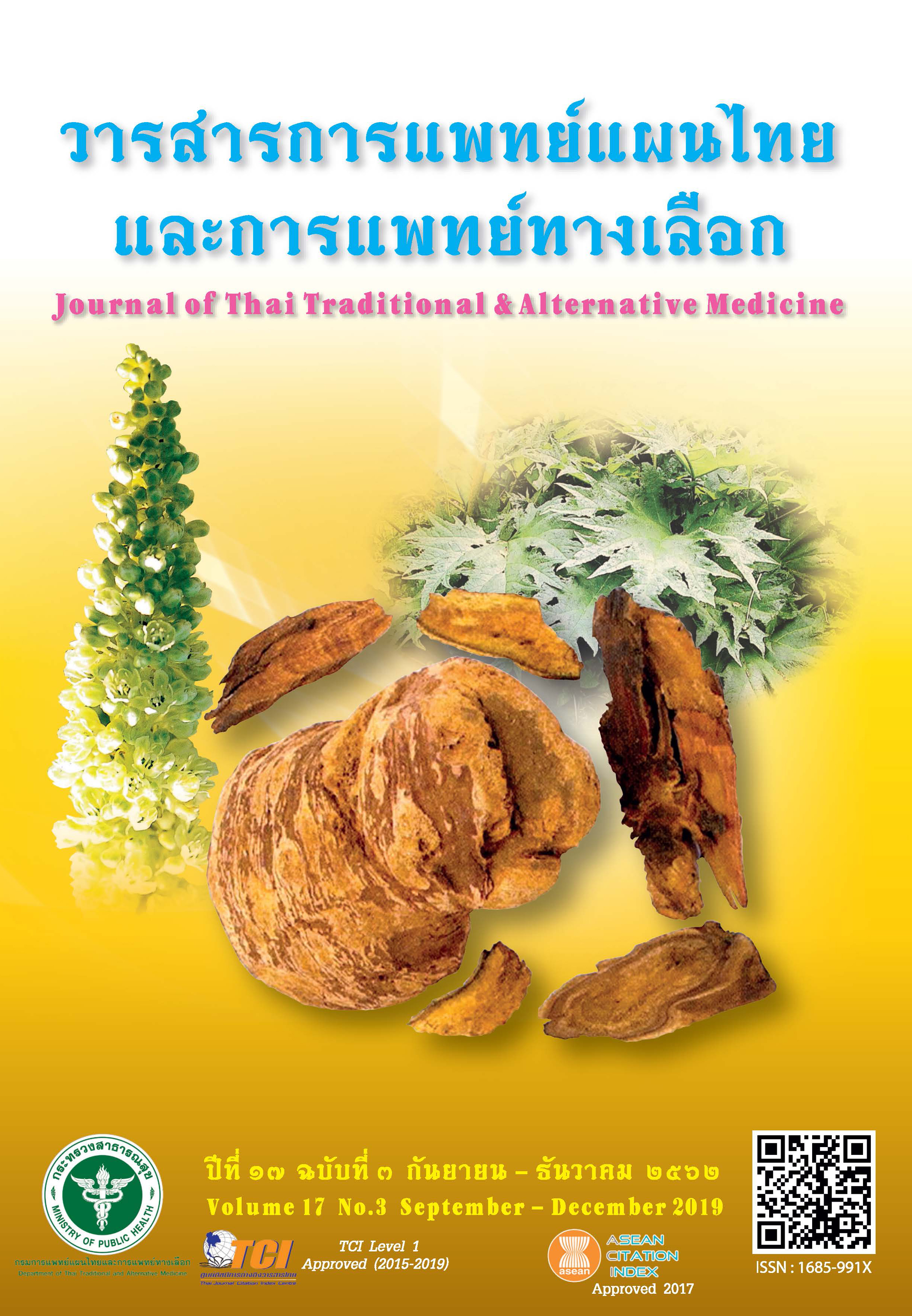The Preliminary Study of Yang Na (Dipterocarpus alatus Roxb. ex G.Don) Extracts on Anticancer and Antifungal Activities and the HPLC Analysis of the Phenolic Compounds
Main Article Content
Abstract
Dipterocarpus alatus Roxb. ex G.Don is a medicinal plant in Asia. In Thailand, this plant was used for skin, rheumatism and liver diseases. This study was determined to assess the anticancer and antifungal activities of the extracts from leaves, bark and twig of D. alatus as well as to identify the phenolic compounds in these extracts using HPLC analysis. The results suggest that all of extracts exhibited the highest cytotoxicity against Jurkat cancer cell line followed by HeLa and HepG2 cancer cell lines but do not show cytotoxicity against the non-cancerous cells (Vero cell line). Regarding its antifungal activity, extracts of the leaves and bark inhibited only T. mentagrophytes but have no capacity against other tested fungal stains. The HPLC analysis revealed the presence of, gallic acid in all extracts. Protocatechuic acid was found only in bark, while, p-coumaric acid and ferulic acid were found in twig. The result obtained suggested that D. alatus might be further explored for its contribution in cancer therapy. The obtained information could be useful for promoting the exploitation of the Thai medicinal plant.
Article Details
References
2. Khiev P, Kwon OK, Song HH, Oh SR, Ahn KS, Lee HK, Chin YW. Cytotoxic terpenes from the stems of Dipterocarpus obtusifolius collected in Cambodia. Chemical and Pharmaceutical Bulletin (Tokyo). 2012;60(8):955-61.
3. Yang WS, Lee BH, Kim SH, Kim HG, Yi YS, Htwe, KM, Kim YD, Yoon KD, Hong S, Lee WS, Cho JY. Dipterocarpus tuberculatus ethanol extract strongly suppresses in vitro macrophage-mediated inflammatory responses and in vivo acute gastritis. Journal of Ethnopharmacol, 2013;146(3):873-80.
4. Bupabanpot J, Ratanapracha S, Poopath M, Phueaknang C, Danchutham A. Conservation and utilization of Dipterocarpaceae.
Bangkok: Department of National Parks, Wildlife and Plant Conservation; 2013. 115.
5. Karnick CR, Hocking GM. Ethnobotanical records of drug plants described in valmiki ramayana and their uses in
the Ayurvedic system of medicine. Quarterly Journal of Crude Drug Research. 1975;13(3):143-54.
6. Wiart, C. Medicinal plants of the Asia-pacific: drugs for the future?. Singapore: world scientific publishing Co.Pte. Ltd; 2006. 139.
7. Prasad PRC. Ecological analysis of Dipterocarpaceae of north Andaman forest, India. Journal of Plant Development. 2011;18:135-49.
8. Zuraida W, Zain WM, Ahmat N, Norizan NH, Ainaa N, Nazri AM. The evaluation of antioxidant, antibacterial and structural identification activity of trimer resveratrol from Malaysia’s Dipterocarpaceae. Australian Journal of Basic and Applied Sciences. 2011;5(5):926-9.
9. Chen CJ, Jiang R, Wang G, Jiao RH, Tancharoen C, Sudto K, Vajarothai S, Hannongbua S, Ge HM, Tan RX. Oligostilbenoids with acetylcholinesterase inhibitory activity from Dipterocarpus alatus. Planta Medica. 2014;80:1641-6.
10. Akter R, Uddin SJ, Grice ID, Tiralongo E. Cytotoxic activity screening of Bangladeshi medicinal plant extracts. Journal of Natural Medicines. 2014;68(1):246-52.
11. Muhtadi HEH, Syah YM, Juliawaty LD, Achmad A, Latip J. Resveratrol tetramer compounds from Dipterocarpus intricatus and activity against murine leukemia P-388 cells. Proceeding of the International Seminar on Chemistry; 30-31 Oct 2008; Jatinangor, Indonesia. Jatinangor: University Padjadjaran; 2008. 585.
12. Huong DTT, Thuy TTT, Hien TT, Tra NT, Tien NQ, Smirnova IE, Kazakova OB, Minnibaeva EM, Tolstikov GA. Synthesis and cytotoxicity of derivatives of dipterocarpol, a metabolite of Dipterocarpus alatus. Chemistry of Natural Compounds. 2013;49(1):58-65.
13. Muhtadi M, Indrayudha P, Wibowo A, Yen KH. Cytotoxic activity of secondary metabolites from the bark of Dipterocarpus Confertus Sloot. Journal of Advances in Chemistry. 2014;9(1):1861-5.
14. Park BC, Bosire KO, Lee ES, Lee YS, Kim JA. Asiatic acid induces apoptosis in SK-MEL-2 human melanoma cells. Cancer Letters. 2005;218:81-90.
15. Park C, Moon DO, Rhu CH, Choi BT, Lee WH, Kim GY, Choi YH. Beta-sitosterol induces anti-proliferation and apoptosis in human leukemic U937 cells through activation of caspase-3 and induction of Bax/Bcl-2 ratio. Biological and Pharmaceutical Bulletin. 2007;30(7):1317-23.
16. Yang S, Zhao Q, Xiang H, Liu M, Zhang Q, Xue W, Song B, Yang S. Antiproliferative activity and apoptosisinducing mechanism of constituents from Toona sinensis on human cancer cells. Cancer Cell International. 2013;13(1):1-12.
17. Gong FK, Wang XQ, Li ZX, Zhang B. α-Viniferin induced apoptosis in K562 cells via mitochondrial pathway. Chinese Pharmacological Bulletin. 2015;31(3):391-5.
18. Srisayam M, Weerapreeyakul N, Barusrux S, Tanthanuch W, Thumanu K. Application of FTIR microspectroscopy for characterization of biomolecular changes in human melanoma cells treated by sesamol and kojic acid. Journal of Dermatological Science. 2014;73:241-50.
19. Tadtong S, Suppawat S, Tintawee A, Saramas P, Jareonvong S, Hongratanaworakit T. Antimicrobial activity of blended essential oil preparation. Natural Product Communications. 2012;7(10):1401-4.
20. Kaisoon O, Siriamornpun S, Weerapreeyakul N, Meeso N. Phenolic compounds and antioxidant activities of edible flowers from Thailand. Journal of Functional Foods. 2011;3(2):88-99.
21. Prayong P, Barusrux S, Weerapreeyakul N. Cytotoxic activity screening of some indigenous Thai plants. Fitoterapia. 2008;79(7-8):598-601.
22. Sourani Z, Pourgheysari B, Beshkar P, Shirzad H, Shirzad M. Gallic acid inhibits proliferation and induces apoptosis in lymphoblastic leukemia cell line (C121). Iranian Journal of Medical Sciences. 2016;41(6):525-30.
23. Jaganathan SK, Supriyanto E, Mandal M. Events associated with apoptotic effect of p-coumaric acid in HCT-15 colon cancer cells. World journal of gastroenterology. 2013;19(43):7726-34.
24. Yin MC, Lin CC, Wu HC, Tsao SM, Hsu CK. Apoptotic effects of protocatechuic acid in human breast, lung, liver, cervix, and prostate cancer cells: potential mechanisms of action. Journal of Agricultural and Food Chemistry. 2009;57(14):6468-73.
25. Zhang X, Lin D, Jiang R, Li H, Wan J, Li H. Ferulic acid exerts antitumor activity and inhibits metastasis in breast cancer cells by regulating epithelial to mesenchymal transition. Oncology Reports. 2016;36(1):271-8.


